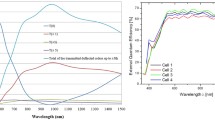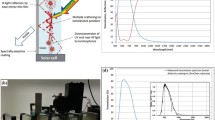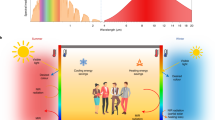Abstract
One of the critical components of energy savings in buildings is thermal insulation, especially for windows in cold climates. The conventional approach mainly relies on a double-pane design. In this study, a new concept of “Green Window” has been designed for single-pane applications that lower the U-factor. The “Green Window” is structurally and simply composed of a thin film window coating of chlorophyll that exhibits pronounced photothermal effect, while remaining highly transparent. We demonstrate a new concept in “thermal insulation” via optical means instead of solely through thermal insulators or spectral selectivity. This concept lifts the dependence on insulating materials making single-pane window highly possible.





Similar content being viewed by others
References
ARPA-E: Single-Pan Highly Insulating Efficient Lucid Designs (SHIELD) Program Overview, URL: https://arpa-e.energy.gov/sites/default/files/documents/files/SHIELD_ProgramOverview.pdf. [accessed January 20, 2019].
J. Han, L. Lu, and H. Yang: Numerical evaluation of the mixed convective heat transfer in a double-pane window integrated with see-through a-Si PV cells with low-e coatings. Appl. Energy 87, 3431–3437 (2010).
S.D. Rezaei, S. Shannigrahi, and S. Ramakrishna: A review of conventional, advanced, and smart glazing technologies and materials for improving indoor environment. Sol. Energy Mater. Sol. Cells 159, 26–51 (2017).
H. Khandelwal, A.P.H.J. Schenning, and M.G. Debije: Infrared regulating smart window based on organic materials. Adv. Energy. Mater. 7, 1602209 (2017).
E. Cuce and P.M. Cuce: Vacuum glazing for highly insulating windows: recent developments and future prospects. Renewable Sustainable Energy Rev. 54, 1345–1357 (2016).
A.M. Alkilany, L.B. Thompson, S.P. Boulos, P.N. Sisco, and C.J. Murphy: Gold nanorods: their potential for photothermal therapeutics and drug delivery, tempered by the complexity of their biological interactions. Adv. Drug Delivery Rev. 64, 190–199 (2012).
Y. Zhao, M.E. Sadat, A. Dunn, H. Xu, C.-H. Chen, W. Nakasuga, R.C. Ewing, and D. Shi: Photothermal effect on Fe3O4 nanoparticles irradiated by white-light for energy-efficient window applications. Solar Energy Materials & Solar Cells 161, 247–254 (2017).
ASTM G173-03(2012), Standard Tables for Reference Solar Spectral Irradiances: Direct Normal and Hemispherical on 37° Tilted Surface. ASTM International (West Conshohocken, PA, 2012).
Measuring Performance: Visible Transmittance (VT). EFFICIENT WINDOWS COLLABORATIVE. URL: http://www.efficientwindows.org/vt. php. [accessed January 20, 2019].
Pilkington: Pilkington K Glass S Brochures. [Online]. Available: https://www.pilkington.com/en-gb/uk/products/product-categories/thermalinsulation/pilkington-k-glass-range/pilkington-k-glass-s%20-. [Accessed January 20, 2019].
X. Huang, P.K. Jain, I.H. El-Sayed, and M.A. El-Sayed: Plasmonic photothermal therapy (PPTT) using gold nanoparticles. Lasers Med. Sci. 28, 217 (2008).
X. Huang, I.H. El-Sayed, W. Qian, and M.A. El-Sayed: Cancer cell imaging and photothermal therapy in the near-infrared region by using gold nanorods. J. Am. Chem. Soc. 128, 2115–2120 (2006).
M. Chu, Y. Shao, J. Peng, X. Dai, H. Li, Q. Wu, and D. Shi: Near-infrared laser light mediated cancer therapy by photothermal effect of Fe3O4 magnetic nanoparticles. Biomaterials 34, 4078–4088 (2013).
K. Yang, S. Zhang, G. Zhang, X. Sun, S.-T. Lee, and Z. Liu: Graphene in mice: ultrahigh in vivo tumor uptake and efficient photothermal therapy. Nano Lett. 10, 3318–3323 (2010).
M. Chu, H. Li, Q. Wu, F. Wo, and D. Shi: Pluronic-encapsulated natural chlorophyll nanocomposites for in vivo cancer imaging and photothermal/photodynamic therapies. Biomaterials 35, 8357–8373 (2014).
D.K. Roper, W. Ahn, and M. Hoepfner: Microscale heat transfer transduced by surface plasmon resonant gold nanoparticles. J. Phys. Chem. C 111, 3636–3641 (2007).
H. Jin, G. Lin, L. Bai, M. Amjad, and E.P.B. Filho: Photothermal conversion efficiency of nanofluids: an experimental and numerical study. Sol. Energy 139, 278–289 (2016).
ASTM C1199-14, Standard Test Method for Measuring the Steady-State Thermal Transmittance of Fenestration Systems Using Hot Box Methods. ASTM International (West Conshohocken, PA, 2014).
J. Carmody, S. Selkowitz, D. Arasteh, and L. Heschong: Residential Windows: A Guide to new Technologies and Energy Performance, 3rd ed. (W. W. Norton & Company, New York, 2007).
U. E. P. Agency: Windows, Doors & Skylights Key Product Criteria. URL: https://www.energystar.gov/products/building_products/residential_windows_ doors_and_skylights/key_product_criteria. [accessed September 12, 2018].
M. Scotter, L. Castle, and D. Roberts: Method development and HPLC analysis of retail foods and beverages for copper chlorophyll (E141[i]) and chlorophyllin (E141[ii]) food colouring materials. Food Addit. Contam. 22, 1163–1175 (2006).
V.P. Perevalov, E.G. Vinokurov, K.V. Zuev, E.A. Vasilenko, and A.Y. Tsivadze: Modification and application of metal phthalocyanines in heterogeneous systems. Protection of Metals and Physical Chemistry of Surfaces 53, 199–214 (2017).
Acknowledgments
We acknowledge the financial support from the National Science Foundation Grants CMMI-1635089 and EEC-1343568. We thank Dr. Andrew Steckel for the use of the Perkin-Elmer spectrophotometer.
Author information
Authors and Affiliations
Corresponding author
Supplementary material
Supplementary material
The supplementary material for this article can be found at https://doi.org/10.1557/mrc.2019.52
Rights and permissions
About this article
Cite this article
Zhao, Y., Dunn, A.W. & Shi, D. Effective reduction of building heat loss without insulation materials via the photothermal effect of a chlorophyll thin film coated “Green Window”. MRS Communications 9, 675–681 (2019). https://doi.org/10.1557/mrc.2019.52
Received:
Accepted:
Published:
Issue Date:
DOI: https://doi.org/10.1557/mrc.2019.52




